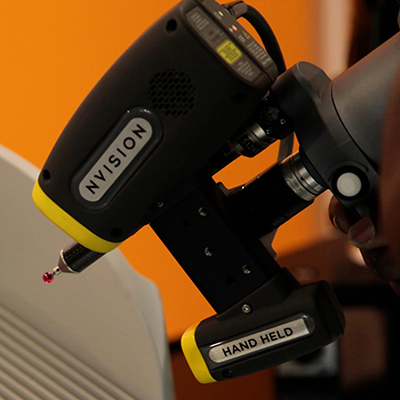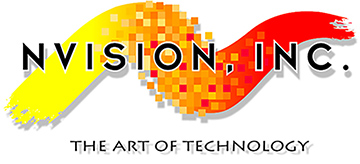NVision’s 3D Scanning Helps Major Aerospace Manufacturer Achieve First-Time-Fit Precision
A major aerospace manufacturer needed to ensure its accessories would fit aircraft exteriors and interiors accurately on the first installation. By turning to NVision’s 3D scanning and reverse-engineering services, the company captured exact aircraft geometries rapidly and with aerospace-grade precision—achieving first-time-fit accuracy, cutting costly rework, and improving flight-performance modeling.
The Challenge
For new aircraft components and add-ons to align correctly on their first installation, engineers must know the aircraft’s true, as-built geometry. Original computer-aided design (CAD) data alone isn’t sufficient because real-world configurations vary from one aircraft to another. For example, interiors may be crowded with cables, hydraulic lines, and other elements that are missing or repositioned in the CAD model.
Traditionally, engineers had to measure components manually using conventional instruments—a slow, labor-intensive process prone to gaps in data and repeated prototype rework. Multiple iterations were common before a proper fit was achieved.
“Getting the perfect fit the first time provides major time and cost savings,” said an aerospace engineer at the company. “We were aware of NVision’s successful work with other aerospace companies, so we contacted them for help.”
NVision’s Approach
To solve these challenges, the manufacturer engaged NVision to provide its 3D laser-scanning and reverse-engineering services. NVision brings a full complement of high-tech scanners to each project, including laser-triangulation systems, time-of-flight (TOF) large-area scanners for big structures, computed tomography (CT) for internal features, and structured-light systems for high-resolution surface capture. Each technology offers unique strengths for specific applications.
 Among the most versatile are HandHeld 3D scanners. Portable and adaptable, they rapidly capture the geometry of objects across a vast range of sizes and shapes—from fighter jets and helicopters to landing-craft propellers and small components like angle-of-attack sensors. NVision’s HandHeld systems are both rapid and precise, capturing up to 60,000 spatial measurements per second with an accuracy of ±0.025 mm (25 microns—about one-thousandth of an inch), making them ideal for inspecting tight tolerances.
Among the most versatile are HandHeld 3D scanners. Portable and adaptable, they rapidly capture the geometry of objects across a vast range of sizes and shapes—from fighter jets and helicopters to landing-craft propellers and small components like angle-of-attack sensors. NVision’s HandHeld systems are both rapid and precise, capturing up to 60,000 spatial measurements per second with an accuracy of ±0.025 mm (25 microns—about one-thousandth of an inch), making them ideal for inspecting tight tolerances.
“Our HandHeld 3D scanner swiftly captures detailed three-dimensional geometry, allowing engineers to collect millions of measurement points with high resolution,” says Steve Kersen, NVision’s President. “Its portability and integrated tracking lets operators move freely around an object while maintaining precise data capture. An optional stand supports field use, while our software enables full mesh processing, alignment, and direct export to major CAD and simulation packages.”
As the scanner’s light sweeps across an object’s surface, it analyzes the reflected light and calculates the distance to each point, generating a “point cloud” of XYZ coordinates that accurately represents the object’s shapes, contours, and dimensions. NVision’s integrated software converts this point cloud into a stereolithography (STL) or other polygonal file for use in CAD platforms such as CATIA, Creo, and SolidWorks. Aerospace engineers then employ these CAD(s) models of the as-built aircraft for measurement, analysis, reverse engineering, inspection, rapid prototyping, and production.
The Results
Partnering with NVision, the manufacturer now obtains accurate, comprehensive 3D data on aircraft geometry in a fraction of the time formerly required by traditional methods—often reducing measurement cycles from days to hours. The precision of the scans and CAD models enables engineers to design and install components that fit correctly on the first attempt—dramatically reducing rework, saving time and cost, and improving safety through more reliable performance modeling. “In its work with us, NVision consistently demonstrates an exceptional ability to deliver the highest levels of accuracy in 3D laser scanning and modeling,” said an aerospace engineer at the company. NVision’s work has yielded additional rewards as well: “Laser scanning has also improved the accuracy of the fluid-dynamic models we use to predict how accessories affect flight performance, providing a distinct safety advantage.”
For more information about NVision’s comprehensive 3D scanning and reverse engineering services, contact NVision, Inc., 577 Commerce Street, Suite 100, Southlake, TX 76092.
Tel: 817.416.8006, Fax: 817.416.8008, Email: sales@nvision3d.com, Web: https://www.nvision3d.com
